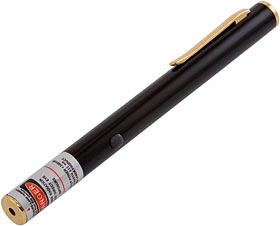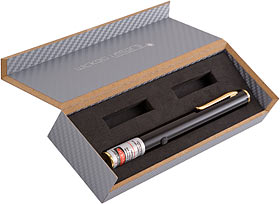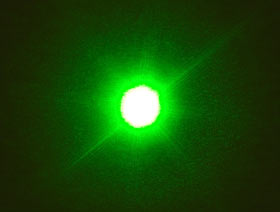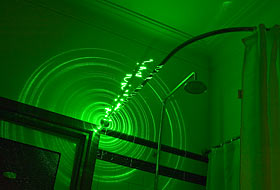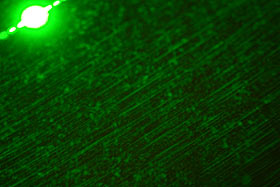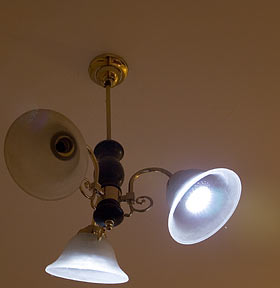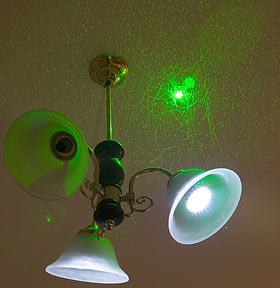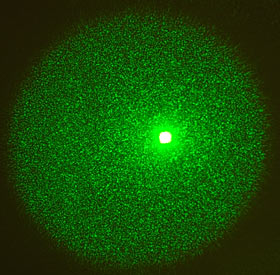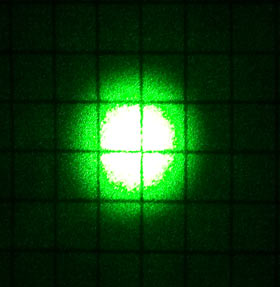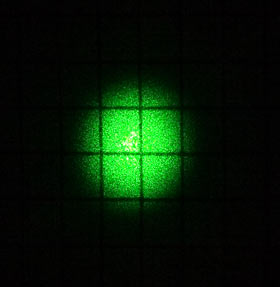
Wicked Lasers "Nexus" green laser
Review date: September 3 2006 Last modified 03-Dec-2011.
I have previously reflected on what kind of items you could take with you on your time-machine jaunt to the past, to prove that you were from the future.
Hand-held lasers definitely count.
It's downright incredible how cheap laser pointers are these days. Base-model red lasers have sold for pocket change for some years now (which explains why they're showing up in all sorts of oddball tools).
The laser diode is the basis of all of the world's cheap lasers, and it's one of those things that obviously ought not to work at all, much less sell for $2 at a flea market.
The first laser diodes lit up 30 years ago - not that anybody could easily tell, since they were infrared. It was many years after that before visible-light versions were remotely affordable. Weedy red pointers still cost $US100 in 1993.
For this reason, the first actual laser pointers were helium-neon units, not diodes.
Laser diodes have the same fantastic ultra-tiny quantum-physics-right-in-your-face sort of basic design as LEDs, but they do something much more remarkable.
Green laser pointers are nothing special these days, either. You can buy 'em on eBay for less than $US30 delivered. Green pointers used to be spectacularly expensive, too - try $US600 in 1998 - and, once again, if you look at how they work it's surprising that they're not still that expensive.
Nowadays, pretty much anybody can buy a green laser. Just because they're as cheap as a decent flashlight, though, doesn't mean they're as simple as one to understand, or as safe as one to use. Which is why this review of a green laser is going to go on, and on, and on.
And on.
Crystals, beams, pure energy...
As I've mentioned before, green laser pointers do not contain an actual "green laser diode", because no such thing yet exists. You can't move a laser diode's output around visible spectrum by just feeding it more power or making it a different size, so although we have infrared, red, blue, violet and ultraviolet laser diodes (the diodes used for HD-DVD and Blu-Ray are "blue-violet", right up at the violet end of the visible spectrum), we don't have yellow or green ones.
Instead, every "green diode" pointer is a "diode pumped solid state", or DPSS, laser. A high powered infrared diode shines into the back of one crystal, which in turn feeds another crystal, and green light comes out the end. This is how the rarer and more expensive yellow pointers work, too.
(Who knew that brainless technobabble involving crystals and beams would ever actually amount to anything?)
More power!
There was, for years, no such thing as a really powerful laser pointer. Pointers varied in real output power between around one milliwatt (mW) and 5mW, and there were and are red diodes with a shorter wavelength output - an oranger red, essentially - which look considerably brighter per milliwatt. But a disco laser in the palm of your hand they were not.
The $30 eBay green lasers have the same low single-digit number of output milliwatts as do ordinary red pointers, but they look far, far brighter, because the human eye's something like ten times as sensitive to green light as it is to red. This is good, in itself; green lasers are common enough now that lots of people have seen how visible the beams are at night (even if you're indoors with the lights on), and there are lots of cool things you can do with them.
But if you'd like a frisson of danger from your handheld laser, 5mW-or-less units don't cut it. Stare into the beam and you'll damage your retina, eventually, but that's it for risks. Brief glances are less harmful than a similarly brief glance at the sun, and there's just not enough energy in the beam for it to interact with the macroscopic world in any of the exciting death-ray ways that all right-thinking people desire.
A boring 5mW-or-less pointer will, just barely, push a Crookes radiometer into turning.
If you shine it into an LED of the same colour (ordinary old low-intensity LEDs work fine), you can measure a volt or so across that LED's pins.
(Some people use this to make a crude laser power meter out of $8 worth of parts - note that this is about the worst calibrated and least linear light meter it is possible to make without some arrangement involving measuring the growth of a vegetable.)
But even if you focus a 5mW pointer down to a teeny dot with a magnifying glass, it won't be able to make a detectable dimple in the softest and most meltable black plastic (or green plastic, for a red laser, or red plastic, for a green laser). You can press the business end of a 5mW to the base of your fingernail or your top lip or, ahem, whatever other sensitive skin you like, and illuminate yourself for as long as you like, without feeling a thing.
Clearly, this Will Not Do.
You don't want a pointer. You want a piercer! A pulveriser! A, um, pyrographiser!
It's the twenty-first century, for Pete's sake. If you can't have a flying car, you should at least be able to buy a sodding ray gun.
Many people share this opinion, and they've been tweaking green laser pointers for about as long as green laser pointers have existed. The DPSS design is pumped by a much more powerful diode than you get in a simple single-stage red laser, so if you cherry-pick your lasers and fiddle with the electronics and/or optics you can make them quite a bit brighter.
Sometimes, when you do this, the result even works for more than a hundredth of a second.
Early on, hobbyists were almost all fooling around with "Leadlight" branded pointers, because those were the first widely available cheap 'n' cheerful models.
Since then, though, numerous dealers, varying widely in expertise and honesty, have popped up to sell up-rated handheld lasers. Some are still buying, tweaking and selling; others have beefy lasers made for them right there in the factory.
One of the bigger names in the second category is Wicked Lasers, who sent me one of their less powerful products for review.
It took me a while to remember, but this is not my first run-in with Wicked Lasers. Two years ago, when Wicked were young and, uh, less wicked, they were selling modified Leadlight lasers on eBay, with a hokey ordering scheme where you bought a basic laser and then paid extra for it to be "upgraded" to whatever power level you actually wanted.
At that time, I bought a 15mW pointer from them for a total of $US147, delivered.
I think the laser I actually got had a "17mW" rating sticker on the box, but it was a while ago.
I was very pleased with that laser. I've still got it, and it's still working fine - though that's not surprising, since I haven't used it for very long, and a green laser that doesn't burn out in seconds can be expected to last for thousands of hours.
The old laser still has noticeably more punch than your standard eBay cheapie of today. Tricks like putting a clear dot on low cloud (!) are significantly easier.
This is not that laser, though it's superficially similar. It's the "Nexus", the least extreme of Wicked's "Extreme Series" when this review first went up, but now part of their "Executive Series". It currently lists for $US369.99, including delivery to anywhere in the world from Wicked's HQ in Shanghai.
Like every other normal green pointer, this one runs from two AAA cells (inserted in the barrel in the usual Leadlight way, with the positive terminals pointing out), and you turn it on with a simple momentary switch on the side. If you want it to stay on when you're not holding it, you have to hold the button down with something - I find a nylon cable tie, pulled to the right size and slid up and down the barrel, works well.
This laser is rated - I think quite honestly - at 95 milliwatts.
So it's not what you'd call cheap, but it offers more than twice as many milliwatts per dollar as I got from my tweaked Leadlight two years ago.
(The Nexus probably also has rather more milliwatts per dollar than you'll get from a $US40-delivered eBay cheapie. If you think those "5mW" lasers really do have 5mW of output power, you're dreamin'.)
You can pay a lot more for a laser from Wicked, or quite a bit less. If you only want a 15mW green pointer, for instance, that'll cost you $US99.99 including delivery to anywhere. And people who'd like to exchange the money that's burning a hole in their pocket for something else that'll do the same thing can pick up fat lithium-powered greens, much cheaper high powered reds, and even the still-exotic blues.
Never mind them for now, though. What can this one do?
Well, 95mW is enough power to do some damage, and not just to your eyes.
The laser comes in this neat little box.
(You should keep it in the box when you're not using it, too. Red diode lasers are pretty durable, but the stacked optics in green ones are easy to knock out of alignment. If that happens, your laser will probably be toast - or at least need precision repairs.)
If you push the Nexus into its storage slot so that the foam presses the power button down and the laser turns on, then after a couple of seconds a thread of smoke will start rising from the foam in front of the laser.
Hold the beam dead still on a piece of red or black plastic - by just holding the plastic over the end of the laser - and it'll dig a tiny crater in it in a matter of seconds, or burn a pinhole right through it if it's thin, like a black garbage bag. Hold your aim well enough and you can pop appropriately coloured balloons, too.
You can, similarly, slowly cut red or black electrical tape with this laser.
This isn't all that astounding an achievement when you think about it, since the melting point of PVC is only 212°C. But it's still rather more ray-gun-ish than you expect from something which most people - not including Wicked themselves - call a "pointer".
Try as I might, I couldn't get this laser to light a match, which is possible with the higher powered Wicked models. The match head smoked, but it didn't quite catch.
(It occurs to me that match-lighting lasers can probably light a match inside a transparent container. Absolutely no other thoughts follow on from this one, of course.)
And, yes, if you shine the Nexus on your skin for a few seconds, it hurts.
All right.
At this point, you may be expecting a bunch of pictures of the Nexus' beam lancing through the night like a, um, lance, and bouncing off mirrors and lighting up glassware and so on.
I feel no very great need to take such pictures myself, since Wicked already have plenty of 'em.
(They've also got a prodigious number of user pictures, and videos, too - note the cigarette being lit. The main gallery page is here.)
Many of the pictures are very impressive, but the reason why I didn't bust myself taking a bunch of my own is that they don't really tell you anything about the specialness of the lasers. Wind up the exposure and you can make any cheap green laser look like Yahweh's Blessed Javelin of Annihilation in a night shot.
And, if your exposure lasts a few seconds...
...you can do painting-with-light stuff like this. Entertaining, but not what you'd call informative; this is what my laser did over a period of six seconds, not what it looked like at any particular moment.
I did, however, do a few non-typical bright laser tricks.
Things to make and do
Beefy green laser pointers are to the usual cheap red kind as rare earth magnets are to boring old ferrites. Everything becomes more fun (and potentially more dangerous...). You don't need a darkened room any more to do classic experiments or play with your breakthrough display device. The dot's even visible on sunlit surfaces.
There are lots of nifty optical tricks you can do with any old red pointer, provided you're in a dark room. Try shining it on the back and front of a spoon, for instance, and look at the interference pattern reflections that greatly emphasise every tiny imperfection in the surface. Any old laser will also let you use a CD or DVD as a diffraction grating (I bought a couple of nice holographic ones from these people). But with a bright green laser, stuff like this keeps jumping out and surprising you. You don't even have to try.
While I was taking dot pictures, my hair dangled in the beam...
...and a whole new diffraction pattern leapt into life.
Rather less accidentally, shooting the laser through a simple pinhole non-lens on my 20D gave...
...this.
(I probably didn't need the silly lens. But letting less light into the camera is a good idea when you're playing with a tape-burning laser.)
Bright lasers just cry out to be shone on things to see what happens.
Yes, farmers and plain old cruel people, they work as bird scarers. Freak out a couple of birds with a green laser dot, and their panic will set the whole flock off.
(I don't know what happens if you try this with flightless domesticated fowls. Don't expect me to send flowers if you take on even one emu.)
And you can, of course, use green lasers to induce your pets to do strange things - though given the eye-damage risk that I'll get to in a moment, sticking with 5mW or lower pointers for this purpose is a good idea. Some cats and dogs are afraid of very bright laser dots, anyway.
Wicked list a variety of other uses for their lasers on their site. Green lasers are indeed good for pointing out stars (or astronomers), and possibly also for lighting up bad guys, though I suppose only in situations where you're pretty sure those bad guys are unarmed and/or already know where you are.
A really really bright laser is also, of course, a marvellous thing to buy if one simply has an expensive toy addiction, or feels the need to compensate for a certain masculine insecurity.
You can even use a green laser as a flashlight.
Ordinary low brightness red laser pointers are close to useless if you want to see where you're going. You can wave them around and try to make out the contours of what the laser's illuminating, but all it really shows you is why robots with laser vision have such a hard time finding their way around.
Even quite cheap green lasers, though, are bright enough (mainly thanks to their green-ness and the abovementioned sensitivity curve of the human eye) that you can shine them on any pale, light-diffusing surface - like the ceiling of most houses - and see quite well by the light that bounces off. If you've got a high powered green laser, the effect becomes quite dramatic.
My normal night-time office illumination, as measured by my Pick A Number And Multiply By Pudding light meter, is about 33 lux. If I turn off the lights and point a moderately bright flashlight at the ceiling - like either of the brighter ones from this review, or this thing on its low brightness setting - I get about 4 lux. Not nearly enough for comfortable reading, but plenty for seeing where you're going.
The Nexus, running from less-than-fresh batteries, also managed 4 lux. All from that one little dot on the ceiling.
It's monochromatic green light, of course, so everything looks like sci-fi alien-vision and you can't make out colours (monochromatic light has a colour rendering index of nearly zero; this can be quite important not just for aesthetic purposes, but also for tasks like reading maps). But it's still a genuine four lux - the lux is a unit weighted by the luminosity function, so it mirrors the response of human vision, taking into account the fact that we see green very well. A red laser with the same output power as the Nexus wouldn't score nearly as well in this test, but that'd fairly reflect its lousier ability to light the room as far as a human's concerned.
Reflected green laser light is certainly a heck of a lot better than nothing, and it's more than good enough for finding your way around, even outside. If you've got a tree, or a rock or something, or even a pale path (less than optimal if the ground's uneven and treacherous...), you can see where you're going with nothing but a green laser to guide you.
(If it's a misty night, you will of course probably attract some New Agers who want you to take them back to your planet.)
This effect also lets you put a small bright source of light on pretty much any surface - well, any surface that isn't black or the opposite colour to the laser, anyway. This lets you make shadows whip around the room in a trippy way, but it can also occasionally be quite useful. Or, at least, educational.
Here, for instance, is one of my living room light fittings.
Yes, those are LED-array lamps. No, they're not terribly interesting. Compact fluorescents are still a much better option.
In this picture, the only odd thing about the fitting seems to be the funny lamps in it. Until I started waving the laser around and making light sources on the ceiling, I was entirely unaware...
...that the fitting was in fact hung with an Addams Family Approved quantity of cobwebs.
I'm not recommending a green laser as an essential housekeeping tool for the modern home. I just thought this was a neat example of the light-source-anywhere effect.
Power
Diode lasers are all pretty inefficient, but DPSS lasers are much worse. They therefore need a fairly robust power supply, by small-flashlight-shaped-thing standards. But they seldom have one. The AAA battery is not renowned for its current delivery capabilities.
Fiddling around with batteries and my bench power supply revealed that the Nexus draws a bit more than half an amp - 0.52 to 0.53A - over the range of voltages it can expect to get from most batteries. 2.8 volts - 0.53 amps. 2.4 volts - still 0.53 amps. This is because the actual diode is fed by a DC-to-DC converting power supply, which makes sure the finicky diode's tight input limits aren't exceeded.
The Nexus' current consumption and beam brightness both drop rapidly below 2.4V, and it peters out completely at about 2.0 volts.
(My old laser has the same shape of voltage-versus-current curve, but its steady current figure is 0.33 amps, which given its much lower output means it's obviously considerably less efficient than the Nexus. The old laser doesn't dim quite as drastically below 2.4V, though it isn't much better in that department than the Nexus, either.)
Alkaline and carbon-zinc batteries have a nominal 1.5 volt rating. A series pair of them, such as is used in these pointers, is thus meant to be good for 3 volts - actually, brand new batteries will give rather more than 1.5 volts when tested with no load. But if you ask for around half an amp from AAA alkalines - don't even ask about carbon-zinc - their voltage will plummet. You'll be lucky if you still get 2.8V out of them, and you'll also get a lot less run time than you might have expected from the 25mA-current capacity rating on the battery spec sheet.
Battery capacity ratings are also commonly calculated with a lower cut-off voltage of 1.0V, at the most. Often, it's 0.8V or something. That's no good for one of these pointers, since they fade below 2.4V from two cells. If you set the cut-off voltage at, say, 1.1V, then you can only expect a service life from normal AAA alkalines, delivering half an amp, of maybe 25 minutes.
Ask for the same thing from a top-flight expensive alkaline, like an Energizer "E2", and you'll get a better result - or, at least, you won't have to continue the lines off the bad edge of the performance chart to figure out what you can expect. E2 AAAs are rated for about one hour service at 500mA down to a 1.0V cutoff, and so should do noticeably better than ordinary cheapie alkalines even with a 1.1V cutoff. They're not amazingly better, and most of the time people buy them for no good reason, but they ought to work pretty well in a high powered pointer.
The Nexus' steady current with diminishing voltage means, as you'd expect, that it's brighter when it's running from fresher batteries. But it's not as linear as you might think, because the laser's efficiency probably changes at different power levels, too - it probably gets a bit more efficient as the input voltage drops, down to a point.
Even if the efficiency stays the same, though, you can expect the 2.4V output to be better than 85% of the 2.8V output. I certainly didn't notice a big difference. And that means that you can use rechargeable NiMH AAA cells in this laser and still get most of its rated power.
NiMH (and the lower capacity NiCd) rechargeables have a 1.2-volt-per-cell nominal rating, but they're much happier delivering high current than are non-rechargeable cells; they give most of their rated capacity, and their voltage doesn't drop. That's good, because if it did then these lasers would fade badly.
Since you can get genuine 900 milliamp-hour (mAh) AAAs now (some of the ones labelled "1000mAh" may actually be telling the truth), you can expect them to power a 0.53A pointer for well over an hour.
The first-class-ticket power option for a pointer like this, assuming you don't have a bench power supply and a long pair of test leads handy, are the recently-released lithium AAAs.
Lithium AA cells have been around for ages, but AAAs are pretty new. They're much more expensive than alkalines, but for high current applications (or situations where weight, shelf life and/or low temperature performance are important), they can be worth it.
Lithium AAs and AAAs use the lithium/iron disulfide chemistry, which gives them an actual native terminal voltage up around 1.7V. This can be dangerous in things like flashlights that don't expect it, but Wicked's lasers are all OK with it, and I think pretty much every other pointer is too.
Lithium cells maintain a high terminal voltage for a long time. By the time one of them gets to 1.2V into a half-amp load, it's close to flat.
Energizer's L92 lithium AAAs (PDF) are rated for a bit more than two hours of service at 500mA, but that's to 0.9V, which is no good to us here. Still, you really ought to get a straight hour of more or less full brightness out of 'em.
Since Wicked's AAA-powered lasers come in a box with pre-cut holes for two spare batteries, you can easily kit yourself out with a couple of NiMH AAAs for most use, and a couple of expensive lithium AAAs for when you really have to show off.
Or, of course, you can just resign yourself to not getting quite full brightness, and use nothing but NiMH. That's the economical way to go - rechargeable batteries can pay for themselves very quickly in high drain applications.
The whole power supply issue would be rather simpler if somebody would just make green pointers that took AA batteries, instead of these weedy AAAs, but such a product just doesn't seem to exist. A fatter, AA-powered pointer would also have extra mass to protect the optics from shock better, and there'd be room for better heat sinking, too.
As things stand, it's possible for a AAA-powered green pointer to boil itself to death. Wicked recommend you only run the Nexus for 100 seconds at a time, with at least a 10 second break in between for the poor thing to cool down. That's not a very onerous duty cycle, and you can probably push it harder when the batteries are weak or if you're just running the thing from NiMH cells, but it's still somewhat alarming.
Wicked's "Spyder" pointers - which currently start at 200 milliwatts and $US999.99 - are powered by CR123 lithium batteries, which are commonly used in high powered flashlights and which are perfectly capable of running a few watts of laser. The Spyders are also rated for a 100% duty cycle - you can run them non-stop, though they still have a momentary switch, to reduce the chance of the laser barbecuing someone's eyeballs because you dropped it while it was turned on.
The laser market could use something in between the AAA and CR123 pointers, or even something that's had a bit more thought put into its case design. I've got an old red pointer that uses two AAs side by side, and is much more comfortable to use than a pen-style unit.
Can you buy that pointer any more? Nope.
Beam behaviour
In Physics Experiment Land, a laser has a tightly defined beam, and throws no light outside that beam. In Simplified Physics Experiment Land, the beam doesn't even diverge. If it's a millimetre wide as it leaves the laser, it's still a millimetre wide when it hits the moon.
In the real world, laser pointers are not precision optical devices. Their beams diverge quite a lot, and the bright dot in the middle is also surrounded by a circle of speckly mess created by refraction and reflections inside the diode assembly, which is probably not painted super-matte-black inside, and which also includes the little lens without which a diode laser doesn't have a "beam", in the narrow laser-y sense, at all.
Here's what I'm talking about. The speckle-disc around the beam of my Nexus looks off-centre because the beam doesn't exit the end of the laser precisely in the centre of the hole in the screw-on end cap. If you remove the end cap, you get a much bigger speckle-disc (fading out nicely toward the edges), and the dot is more or less in the middle of it.
The laser's actual aim is fine - I can't eyeball any off-centre-ness in the beam itself. It is not like one of those cheap penlights whose beam exits the light at a 20 degree angle to the direction you're pointing it.
Removing the end cap, by the way, is about as far are most people are going to want to go in dismantling one of these pointers, but the diode module seems to be screwed in place inside; if you've got a hankerin' to use a super-diode to upgrade your freaky board game or whatever, all you should need is a somewhat deeper than usual pin-drive or "snake eye" screwdriver.
The rubbish around the main beam isn't a big deal for most purposes, and it's much less bright than the beam itself. But green pointers in general and high powered green pointers in particular can be expected to have a quite noticeable speckle-disc around the dot. If that's a problem for your Optics Desk On A Budget sort of application, then you're going to need to add some kind of baffle or snoot or something to the nose of the laser.
On to divergence.
You can't expect any diode laser's beam to diverge by less than about one millimetre per meter, and 2mm/m is common. The initial beam width inside the diode is minuscule - the actual lasing spot is commonly referred to as being "about the size of a bacterium" - but the behaviour of light means that a laser that starts out super-narrow will diverge very quickly, and that is indeed what a diode laser naturally does. A bare laser diode throws a broad, flashlight-like spray of light, not a "beam" at all. You can see this easily by dismantling a cheap red pointer; if you can unscrew the little lens from the front of the diode assembly, you get a weird grainy red flashlight.
To get a narrow beam out of a diode laser, you need that little collimating lens. It gives the beam a larger effective initial width and, thus, lower divergence. But you still can't expect miracles - if you need less than one millimetre per metre divergence, a diode laser is not for you.
Technically, beam divergence is specified in milliradians. The radian is a large unit of angle - about 57.3 degrees - but a one milliradian change of aim can be closely approximated as a nice neat one metre difference at one kilometre, so it's a popular measure among people whose job involves delivering bits of metal at very high speed to other people a long way away. The measurement has thus ended up being used in less dangerous optics as well.
Wicked spec the Extremes as having 1.2mRad divergence or less. I made a vague attempt at checking this by printing out a bit of graph paper with 2mm squares on it. I then shot the Nexus at it from about 2.9 metres away.
The exact distance doesn't matter that much, because it's hard to define exactly how big the dot actually was, even at that quite close range.
Here's what it looked like in a 1/500th of a second exposure (at f/16, ISO 100). The middle of the dot is overexposed, but the halo around it is quite bright too.
Here it is at 1/4000th of a second. No longer overexposing the middle, but not showing as much halo, either.
From this, it seems fair to say that we're talking four to five millimetre beam width at 2.9 metres. That makes sense - start with a 1mm beam and add 1.2 millimetres per metre, and that's about what you'll get. This also means the beam can be expected to have expanded to around 1.1, maybe 1.2, metres in diameter at one kilometre.
Beam divergence, of course, means that even the most ludicrously powerful laser pointers will only be able to do their chopping, burning and popping tricks at relatively close range. Apart from the fact that tiny movements of the laser will cause the beam to jump around a lot at long range, a 2mm-wide beam has a quarter of the intensity per unit area of a 1mm-wide one, a 3mm-wide beam has a ninth, and so on.
All this explains why people don't use diodes when they need a hard core lab laser. Apart from the fact that you can't get a diode that emits various spectra, like X-rays, that're essential for some scientific purposes, you also just can't get the atom-tickling beam quality from a diode that the older, more awkward technologies offer.
If you hunt around, you can find some diode lasers being used for serious science applications.
Satellite Laser Ranging stations like this one typically use neodymium-doped yttrium aluminium garnet (Nd:YAG) lasers with a doubler crystal to turn their IR beam into green - but some of them are proud to have upgraded to diode lasers.
The Greenwich Prime Meridian laser is basically just a light show, but it's a light show produced by a lab diode laser - a Spectra-Physics Millennia Vs, to be exact, which is a five watt 532nm DPSS unit that must have cost a pretty penny when it was installed in 1999. Spectra-Physics diodes are reasonably common in labs, but usually only as cheap(ish) sources of bulk laser light to pump some other optical widget.
But, in general, bright diodes are not so good for scientific applications.
They're pretty good for blinding people, though.
How good, exactly?
Read on.
Danger
There are two distinct risks associated with high powered laser pointers.
The first risk is physical harm. The obvious way this'll happen is eye damage from direct or reflected viewing of the beam. Temporary dazzling can cause permanent harm as well, though, if someone's dazzled while they are, for instance, driving a car.
(Or, more sensationally, flying a plane.)
The second risk is getting busted, either for doing something dumb with your laser (see above), or because the things are just plain illegal where you live.
Let's look at the first risk first, because it is, at least officially, why the second risk exists.
The magic number in laser safety is the Nominal Ocular Hazard Distance, or NOHD. The NOHD is the distance from the laser at which it's still possible for its light to exceed the Maximum Permissible Exposure, or MPE, for whatever kind of laser it is.
The MPE for eye exposure is the level above which the laser can cause eye injury.
Given that it's internationally agreed that a given laser won't cause eye injury if you're exposed to less than the MPE, it's pretty clear that exceeding the MPE by 10% is not going to result in instant and permanent blindness. But retina damage never gets better, and the brain is very good at spackling over retina damage so you don't notice it - it can't replace the visual data you would have gotten from a blind spot, but it can make you fail to notice you've hurt yourself until you've hurt yourself quite a lot more.
And your laser may be more powerful than you think it is.
For all of these reasons, MPE is not one of those overly conservative safety regulations that exist only to prevent people from getting sued. MPE and NOHD matter, and it is wise to pay attention to them, even when you know that some degree of overexposure is very probably not going to do you any harm.
You're allowed to be less concerned about NOHD if you're sure that everyone the laser could possibly hit is wearing safety goggles, or if you're playing with your super-pointer on a foggy day, or if you are pathologically antisocial. Otherwise, it matters.
It's less than trivial to figure out the exact MPE and NOHD for a given laser, but if you know the wavelength, output power and divergence, you can make a good enough guess to satisfy anybody who isn't in the retina scanning or laser show business.
Laser-Professionals' online risk analyser here makes it about as easy to figure out NOHD figures as it's going to get - though the couple of "entry ignored **********" fields in the calculator do not fill me with confidence about the coding skills of the people who made it.
Note that because this is a simple calculator, it doesn't factor in particulates in the air. In real world situations, the smoke and dust and such that allow you to see the beam also attenuate it, so actual hazard distances drop by a bit more.
Anyway, I started out by entering the details for one of Wicked's monster 300mW Spyders. They're specced as having less than 1.5 milliradian beam divergence, so I entered a pessimistic (from an eye damage viewpoint) 1 mRad for that, and a 1mm initial beam diameter - which is probably a bit on the high side, but is nearly irrelevant to the NOHD calculation.
For a standard rule-of-thumb exposure time of 0.15 seconds, that gave a NOHD of a decidedly non-trivial 163 metres. Increasing the beam divergence to 1.5mRad dropped that to 108 metres - but that's still a long way. It qualifies as "the length (or, in certain cases, width) of a football field".
Ocular laser exposure isn't cumulative. Retina damage happens because the laser light heats the retina, and the goo inside your eyeball sinks the heat away quickly when the light goes away. So ten 0.1 second exposures over five seconds do not give the same exposure as a single solid one second dose. But this works the other way, too; a fifth of a second is more than twice as dangerous as a tenth.
It should also be noted that at football-field distances, it's downright difficult to keep a laser dot on someone's face for long. At that range, most people will just about be able to keep a hand-held laser's dot inside a 50cm circle. The dot'll be ten or 15 centimetres across, of course, which makes aiming easier, but the individual exposure times will still probably drop significantly, even if you're trying to hit someone's eyes.
Even if all of these variables put together mean the real risk distance for a 300mW laser drops to only 50 metres, though, that's still a pretty impressive distance at which to silently barbecue a retina. There's close to zero evidence that ordinary low-powered pointers pose any risk to people who don't stare into the beam at close range for rather a while, but when you've got more than thirty times the power, things get more alarming.
For the 95mW Nexus running at full power with a 1mRad divergence, the NOHD is 91.4 metres for 0.15 seconds of exposure. If the beam divergence is the maximum specified 1.2 milliradians, NOHD is still 76 metres.
If you bought a cheap laser on eBay and ended up with a 5mW, 1.2mRad unit, the NOHD for a 0.15 second glance will be a much less alarming 17.5 metres. Still a significant risk for indoor play, though.
If your cheap laser turns out to only output 2mW - which is perfectly possible - 0.15 second NOHD drops to 11 metres.
For a piddly one milliwatt key-ring pointer, you have to stare into the beam for at least a quarter of a second before the seven-metre-or-so NOHD kicks in at all. Below that time threshold, your retina probably can't suffer enough heating to be damaged by a 1mW laser at any range.
The colour of a visible-light laser has no impact on NOHD, by the way; a milliwatt is a milliwatt, whether it's 532 nanometre green light or 650nm red. A red laser that looks as bright as a given green one will have a lot more output power, though, and that will increase the NOHD.
To sanity check these numbers, I turned to laser class definitions. The class definitions for lasers were revised in 2002, but in both systems the brightest "harmless" visible-light lasers are called "Class II". Class II lasers are bright enough to damage your eye if you deliberately stare into the beam, but accidental exposure presents no risk, because any normal human's blink response will prevent them from ever reaching the MPE.
Old-system Class II lasers were defined as topping out at only one milliwatt of output power; new-system Class IIs don't have a defined maximum power, but it's not going to be much more than 1mW.
The modern system's next step up for collimated-beam lasers is Class IIIR, which can output up to 5mW and are defined as presenting a real, but low, risk of injury. These are "Eye Safe with Caution" lasers.
Wicked's products are all in the modern Class IIIB, which tops out at 0.5 watts and is the "Eye Protection Required" category.
The problem, of course, is that most people who buy these things don't also buy eye protection. To their credit, Wicked sell quality safety goggles at cost on their accessory page (along with a fancy storage case, and a lightsaber hilt in which you can insert a pointer...). But they don't encourage you to buy goggles with your laser, and they didn't provide me with any, either (apparently they love these guys more).
Nor do Wicked go out of their way to warn people that although their pointers look and feel much like a harmless Class II laser, all but the weediest of them can actually, arguably, be placed somewhere on the danger spectrum around an X-Acto knife (though probably a fair way below a sword).
Wicked mention "the rules of laser safety", but don't bother to actually tell their customers what those rules are.
All this is easy enough to fix, though. No serious nannying is called for - Wicked should just put an interstitial page in their ordering system that makes clear in large type the class of laser you're buying, and tells you that you'd better wear eye protection while using it, and watch where you point it, or it's your own lookout. Or lack thereof, as the case may be.
(Fox News would appear to be somewhat alarmed about Wicked Lasers, a fact which naturally utterly delights them. They proudly make the Fox clip available for download from their site.)
DPSS lasers can actually be more dangerous than their output power suggests. Some infrared light from the diode always leaks through the optics and invisibly increases the output power. In a well-made and correctly operating DPSS pointer that IR light should be insignificant, because the second-last component in the standard DPSS pointer's optical chain is an IR-blocking filter. But the filter may or may not be working properly in a cheap or damaged pointer - a proper filter may not even be present in the dodgiest eBay pointers. A filterless pointer could be emitting 2mW of visible light and 100mW of IR, for all you know. The IR won't be as well collimated by the lens as the visible light (because blue bends best), but it'll still be tight enough to be dangerous at close range.
(Oh, just in case you were considering it: Don't peer into a military IR laser rangefinder. Thank you.)
If your green laser doesn't emit significant IR, then you can protect yourself from it with any red-tinted glasses or goggles. The more they seem to attenuate the beam, the more they really do; it's not like sunglasses, some of which do not actually block UV light.
Likewise, green glasses will protect you from red lasers. All you need is a goggle colour that's more or less complementary to the colour of the beam.
(A pair of cool red-tinted skater shades won't, of course, protect you as well as proper deep red goggles, and glasses that don't completely surround your eyes won't protect you at all from a beam that comes around the edge of a lens. You also may have seen optics experimenters wearing goggles that're the same colour as the beam of their laser. This may be because it's a stupid staged press photo, or because they're using a dim safe beam of one colour to mark the path of a bright dangerous beam of another, or just because they want to enhance the visibility of an otherwise hard-to-see beam. As far as protection goes, same-colour-as-the-beam goggles do nothing.)
So, yeah, there really is a reason why these things are illegal in some countries.
Wicked Lasers have an... outspoken... attitude when it comes to laser laws.
I think that attitude can fairly be summed up as: "Screw 'em!"
Wicked, you see, cheerfully "guarantee the worldwide delivery of our handheld lasers to all countries except Iraq", and promise to give you a hundred dollar refund even if your only problem is that your laser took more than a week to arrive (as long as it's not just delayed by your postal service).
If your laser doesn't arrive at all, as it might not if it's not legal in your country and your local Feds confiscate it, Wicked promise to give you a full refund plus $US100.
What this actually means, of course, is that the intersection of the sets of countries where bright lasers are illegal, and countries where Wicked's customers live, does not contain any countries whose Customs services are actually any good at catching individual personal imports of prohibited pointers.
Thanks to the sterling efforts of well-informed politicians who most certainly do not spout utter claptrap at every opportunity, pointers as bright as the Nexus are clearly and unequivocally illegal in NSW, Australia, where I live (there's a loophole for scientific users, but good luck proving you are one).
Actually, all pointers with output over one milliwatt are officially illegal here. A 95mW pointer is probably grounds for summary execution, and I believe 300mW will also earn execution of your family and burning of your house.
This might not apply to all Australian States and Territories; I haven't pored over the law in detail. Laser pointers definitely do keep showing up in the middle of lists of hilarious ninja equipment that you're also not allowed to have, though. Personally, I think something shouldn't be categorised as a "prohibited weapon" if it's less useful in a fight than a ballpoint pen, but maybe that's just me.
Anyway, all this should make perfectly clear to you that I didn't test my Nexus here in Australia.
Obviously, I flew to the Wicked factory in China.
Anybody who suggests that my Wicked pointer whistled through Australian Customs in a package marked "pen light", declared value $8, is a filthy liar.
And any suggestion that I, or any of Wicked's other customers, have ever used one of their products anywhere near any recognisable Sydney landmarks must of course be entirely incorrect.
Back in the real world, people who own high powered laser pointers in Australia, and in various other countries where they're officially illegal, seem to be free to do so. Well, as long as they manage to resist the urge to be a dick.
(Note that some people use lasers as emergency survival kit "flares", to attract the attention of rescuers. Lasers that're purpose built for this purpose have line optics that make it easier to sweep the fan-shaped beam over a rescue plane or boat. But a high powered green laser would work fine, too - it's not hard to hit a plane with one, it's just not a great idea to try, in normal circumstances.)
It's possible that dickishness will win the day and there'll be a real crackdown at some point, particularly now that green pointer prices have dropped far enough that any, um, jack-monger whose idea of a good time is standing on a highway overpass blinding drivers can afford one. But, thus far, those people seem to have remained happy with the more direct strategy of dropping rocks on cars, and the cops seem to have better things to do than hassle people whose high powered laser is not being shone on (a) other citizens' faces or (b) the cops' chests.
So as long as nobody in government decides you've got a dastardly plan to use your pointer to make an H-bomb or something (not that much less plausible than what people have been busted for already), I reckon you'll be right.
If you're a bit of a tit, try to repress your natural urges when you're playing with your laser, before you spoil the fun for the rest of us.
Other options
If all you care about is milliwatts per dollar, bear in mind that Wicked will sell you a 150mW "Pulsar" red laser for slightly more than half the price of this 95mW green. Because the red one's a direct radiating diode without any frequency twiddling crystals, it also draws only about two thirds as much current from its AAA cells, and can run non-stop with no pauses to cool down.
150mW worth of the Pulsars' 650nm output will only look about as bright as 15mW worth of 532nm green, but red lasers have just as much burning power (for tape, balloons, cigarettes and retinas...) as a 150mW green, provided of course you use targets of the appropriate colour.
Overall
If you're the kind of person who hurries to buy things that may be made illegal by some busybody in the near future, then you may be putting a Wicked laser on your to-buy list already, just in case it comes in handy one day.
If you've just been meaning to get a green laser to play with when the prices became reasonable, though, one of Wicked's 15mW models will suit you just fine, very probably give you the brightest laser in your suburb, allow you to do lots of cool optical tricks, and not be terribly likely to strike you, your family or your pets blind.
Of course, 15mW won't set nothin' on fire, either.
So it's a trade-off.
Dangerous Science Toys are usually a bit easier to spot than one of these inoffensive little pen-shaped things.
A 95mW laser - even a 300mW one - isn't anything like as dangerous as even an air
rifle, let alone any real firearm. But it is not daft to take safety precautions if
you're playing experimenting with one of these things. Laser safety
glasses are not warning-label-on-the-champagne-bottle
sorts of things.
But, you know, there's only so much fun you can have without endangering yourself.
Recommended.
Review laser kindly provided by Wicked Lasers.
